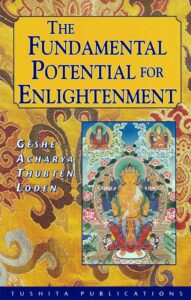By Michael Joseph
“The truth body has transcendental bliss because the obstructions to omniscience have been overcome. The obstructions to omniscience are: (1) the subtle latency of the conception of inherent existence, (2) the appearance of inherently existent objects to the six consciousnesses and (3) the stains of apprehending the two truths as different substantial entities.”
Page 97, The Fundamental Potential for Enlightenment, Sera-Je Geshe Acharya Thubten Loden
The goal of Mahayana Buddhist practice is, for the benefit of sentient beings, to achieve Buddhahood. So, what is Buddhahood? What are we aspiring to achieve? One way in which the texts explain Buddhahood is through a discussion of the Buddha’s four bodies.

Those four bodies can be further summarised into the two bodies – the truth body and the form body. The form body is a Buddha’s form – a Buddha’s appearance in various ways to benefit sentient beings. The truth body is a Buddha’s mental body.
In the paragraph cited above Geshe-la explains that the way to achieve a Buddha’s truth body is through purifying the obstructions to omniscience. The Buddha’s omniscient mind simultaneously perceives all objects of knowledge: both conventional and ultimate truths. The three obstructions are:
- The subtle latency of the conception of inherent existence. Nothing whatsoever exists inherently. For something to exist inherently would mean for it to naturally exist from its own side, by way of its own power. So, for example, when we see a beautiful object we mistakenly believe it naturally has the characteristics of being beautiful. It appears to our mistaken awareness as being independently beautiful. We don’t realise that its beauty depends on our own perception. Whenever we grasp at the inherent existence of any object, this creates a subtle latency.
- The appearance of inherently existent objects to the six consciousnesses. Other than when in meditative equipoise directly perceiving emptiness, everything that appears to any of the six consciousnesses of a sentient being – sight, hearing, taste, smell, touch and mind consciousness – appears incorrectly as being self-sufficiently, independently and inherently existent.
- The stains of apprehending the two truths as different substantial entities. The two truths are conventional truth and ultimate truth. Ultimate truth is emptiness – the emptiness of inherent existence of a conventional truth, which is the base of that emptiness. Ordinary beings can perceive either emptiness or conventionalities, and relate with them as being different substantial entities. They cannot perceive both at the same time. Whereas a Buddha simultaneously perceives both an object’s conventional and ultimate natures.
The way of purifying the obstructions to omniscience is through the practice of the Bodhisattva’s six perfections.
For more information about the six perfections please see p 649 in the Path to Enlightenment in Tibetan Buddhism. To learn more about The Fundamental Potential for Enlightenment click here.
